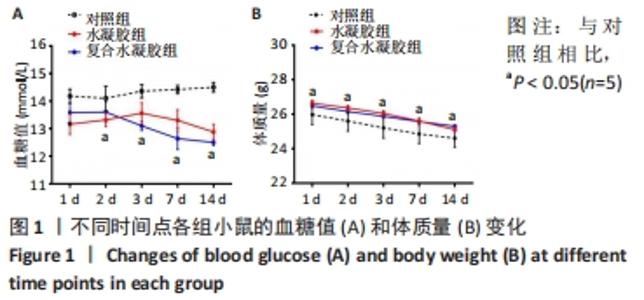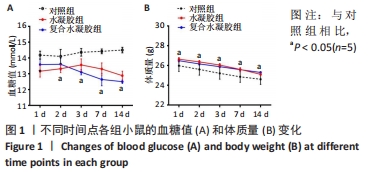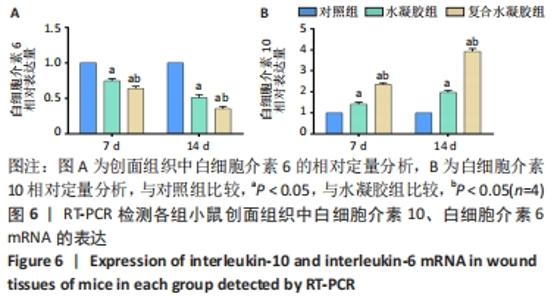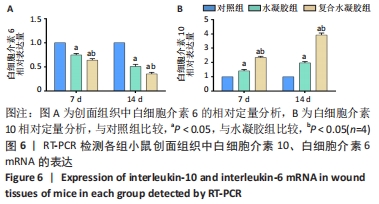Chinese Journal of Tissue Engineering Research ›› 2023, Vol. 27 ›› Issue (1): 21-27.doi: 10.12307/2022.714
Previous Articles Next Articles
Effects of hydrogel loaded with human umbilical cord mesenchymal stem cells on diabetic wound repair in mice
Liu Siqi1, Wu Mingrui1, Qiao Lingran1, Xie Liying1, Chen Siyu1, Han Zhibo2, Zuo Lin1, 3
- 1Key Laboratory of Cellular Physiology, Ministry of Education, and Department of Physiology, Shanxi Medical University, Taiyuan 030001, Shanxi Province, China; 2Hematology Hospital of Chinese Academy of Medical Sciences/Institute of Hematology, Chinese Academy of Medical Sciences, Tianjin Oncay Cell Genetic Engineering Co., Ltd./National Engineering Research Center for Cell Products, Tianjin 300041, China; 3Key Laboratory of Birth Defects and Cell Regeneration, Department of Biochemistry and Molecular Biology, Shanxi Medical University, Taiyuan 030001, Shanxi Province, China
-
Received:2021-10-19Accepted:2021-11-30Online:2023-01-08Published:2022-06-02 -
Contact:Zuo Lin, Associate professor, Key Laboratory of Cellular Physiology, Ministry of Education, and Department of Physiology, Shanxi Medical University, Taiyuan 030001, Shanxi Province, China; Key Laboratory of Birth Defects and Cell Regeneration, Department of Biochemistry and Molecular Biology, Shanxi Medical University, Taiyuan 030001, Shanxi Province, China -
About author:Liu Siqi, Master candidate, Key Laboratory of Cellular Physiology, Ministry of Education, and Department of Physiology, Shanxi Medical University, Taiyuan 030001, Shanxi Province, China -
Supported by:the Shanxi Youth Fund, No. 201601D202106 (to ZL); the Shanxi “1331 Project” Key Subjects Construction, Nos. 1331KSC, XK201708 (to ZL)
CLC Number:
Cite this article
Liu Siqi, Wu Mingrui, Qiao Lingran, Xie Liying, Chen Siyu, Han Zhibo, Zuo Lin. Effects of hydrogel loaded with human umbilical cord mesenchymal stem cells on diabetic wound repair in mice[J]. Chinese Journal of Tissue Engineering Research, 2023, 27(1): 21-27.
share this article
Add to citation manager EndNote|Reference Manager|ProCite|BibTeX|RefWorks
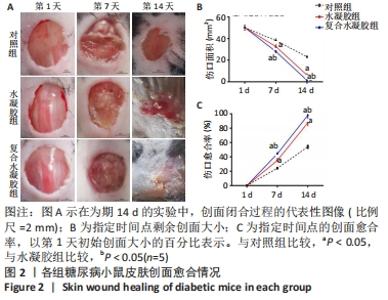
2.2 负载人脐带间充质干细胞的水凝胶促进创面愈合 通过观察不同处理组小鼠创面的愈合速度发现,水凝胶组和复合水凝胶组的创面愈合速度明显快于对照组;进一步测量创面的面积,与对照组(38.16±1.63) mm2,(23.14±0.95) mm2和水凝胶组(32.60±1.55) mm2,(6.21±0.54) mm2相比,复合水凝胶组小鼠在第7天和第14天的面积明显缩小,分别为(28.00±1.27) mm2,(1.39±0.12) mm2,差异有显著性意义(P < 0.05),见图2,同时,复合水凝胶组的疗效略优于单纯水凝胶组。以上结果提示:水凝胶在一定程度上能够促进糖尿病皮肤创面愈合,而人脐带间充质干细胞可进一步增强其疗效。"
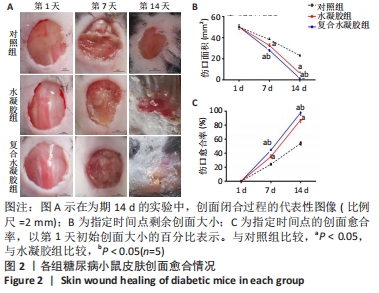
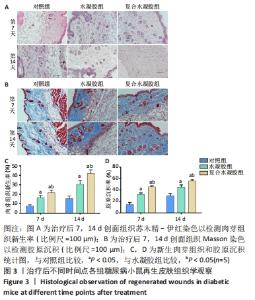
2.3 负载人脐带间充质干细胞的水凝胶可促进创面局部肉芽组织的形成 从组织学观察结果来看,在治疗后第7天,与对照组(7.64±0.75)%和水凝胶组(16.57±1.59)%相比,复合水凝胶组创面处有明显的肉芽组织新生(21.76±2.32)%,差异有显著性意义(P < 0.05),其特征是在组织中存在大量松散的细胞结构;到治疗后第14天,复合水凝胶组的肉芽组织新生率(42.00±3.84)%依旧显著高于对照组(15.46±1.26)%和水凝胶组(30.68±2.48)%,差异有显著性意义(P < 0.05),见图3A,C,说明此时复合水凝胶组创面附近已经形成更多的新生肉芽组织,其结构变得更致密,提示复合水凝胶可促进创面肉芽组织新生。 2.4 负载人脐带间充质干细胞的水凝胶可促进创面局部胶原沉积和血管再生 根据Masson三色染色结果表明,在治疗后的7 d内,所有小鼠均会在创面周围出现胶原沉积,而创伤后的14 d内,胶原分布在整个创面的表面。在创伤后的第7天和第14天的染色结果,能够看出复合水凝胶组形成的胶原沉积比例[(44.63±1.06)%,(55.90±0.84)%]高于同期水凝胶组[(31.62±1.15)%,(45.04±1.43)%]和对照组[(14.84±1.34)%,(30.51±1.49)%],差异有显著性意义(P < 0.05),见图3B,D。"
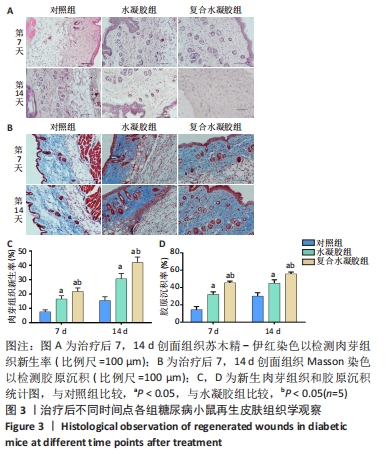
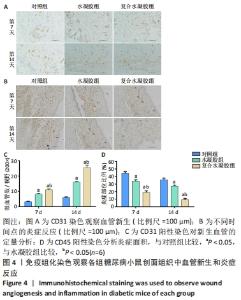
对创面组织的石蜡切片进行CD31免疫组织化学染色观察血管的形成,结果显示:复合水凝胶组在第7天和第14天新生微血管数量分别为(11.00±0.58),(25.50±0.61)个/视野,高于同期水凝胶组[(8.17±0.48),(16.00±0.52)个/视野]和对照组[(3.17±0.17),(6.00±0.37)个/视野],差异有显著性意义(P < 0.05),见图4A,C,表明由复合水凝胶治疗后的创面组织中血管生成速度加快。以上结果提示复合水凝胶治疗可促进损伤部位的血管生成速度加快;增加胶原沉积,创面愈合加速。 2.5 负载人脐带间充质干细胞的水凝胶可抑制创面局部的炎症反应 对创面组织的石蜡切片进行CD45免疫组化染色,结果表明:治疗后的第 7 天,复合水凝胶组的炎细胞浸润比例(18.94±0.87)%显著低于对照组(44.16±0.99)%和水凝胶组(33.96±0.77)%,差异有显著性意义(P < 0.05),治疗后第 14 天,3 组的炎细胞浸润比例分别降至 (35.84±0.90)%, (27.42±0.53)%,(9.26±0.79)%,差异有显著性意义 (P < 0.05),见图4B,D,说明复合水凝胶可在损伤部位发挥一定的抗炎作用,抑制损伤部位炎症细胞的浸润,加速皮肤创面的愈合,而人脐带间充质干细胞可增强这一疗效。 "
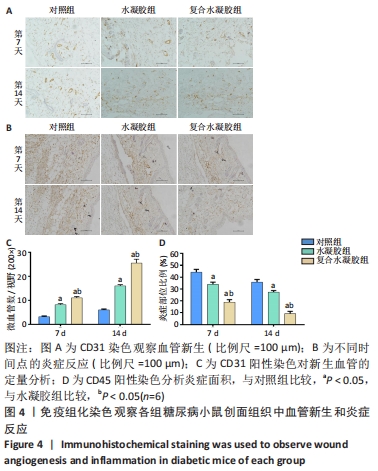
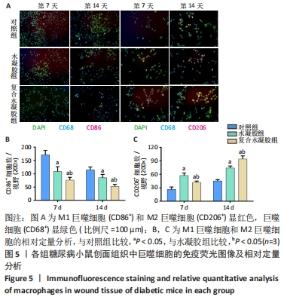
2.6 负载人脐带间充质干细胞的水凝胶可促进巨噬细胞向M2型极化并促进白细胞介素10的释放 在治疗后的第7 天和第 14 天,对不同处理组小鼠皮肤组织切片进行免疫荧光染色,分别标记M1(CD86+、CD68+)和M2(CD206+、CD68+)巨噬细胞,研究结果表明:与对照组和水凝胶组相比[(45.33±1.76),(74.00±2.65) 个 / 200×视野 ],复合水凝胶治疗组分布有较多的M2 型巨噬细胞[ (94.00±4.04) 个 /200× 视野],差异有显著性意义 (P < 0.05),见图5。RT-PCR结果显示,复合水凝胶治疗后,创面组织中M2型巨噬细胞相关因子白细胞介素10的表达水平为3.92±0.14,明显高于同期水凝胶组和对照组(1.97±0.10,1.00±0.00);而复合水凝胶组M1型巨噬细胞相关基因白细胞介素6的表达水平为0.36±0.03,显著低于同期水凝胶组和对照组(0.51±0.04,1.00±0.00),见图6。以上研究提示:人脐带间充质干细胞复合水凝胶对创面的抗炎作用可能是通过促进巨噬细胞向M2表型极化以及白细胞介素10的释放实现的。"
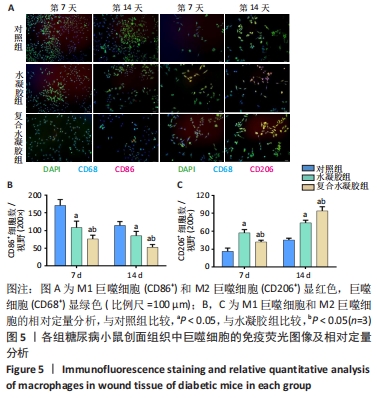
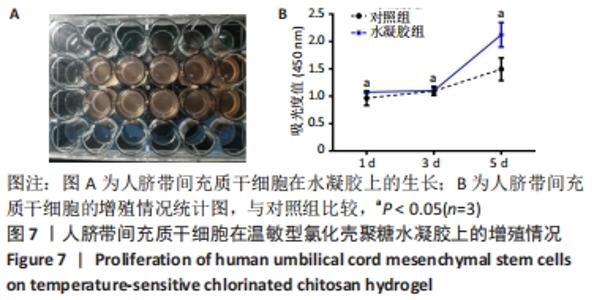
2.7 生物相容性 复合水凝胶的生物相容性通过人脐带间充质干细胞培养和体内实验进行。细胞实验分别对完全培养基和复合水凝胶中培养的人脐带间充质干细胞进行细胞增殖活性分析,CCK-8 结果显示:复合水凝胶中人脐带间充质干细胞在第 1,3,5 天的增殖率 (1.10±0.02,1.10±0.08, 2.12±0.22,P < 0.05) 明显高于同期对照组 (0.96±0.13,1.10±0.07,1.49±0.21,P < 0.05),见图7,提示复合水凝胶对人脐带间充质干细胞的增殖有一定的促进作用;在体内实验中,小鼠未出现由敷胶治疗引起的异常,生长状态良好。以上结果说明水凝胶具有良好的细胞相容性和无毒性,可作为负载人脐带间充质干细胞的良好载体进行皮肤损伤的治疗。"
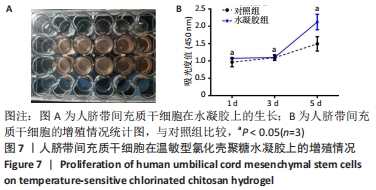
| [1] DONG Y, RODRIGUES M, KWON SH, et al. Acceleration of Diabetic Wound Regeneration using an In Situ-Formed Stem-Cell-Based Skin Substitute. Adv Healthc Mater. 2018;7(17):e1800432. [2] HYLDIG K, RIIS S, PENNISI CP, et al. Implications of Extracellular Matrix Production by Adipose Tissue-Derived Stem Cells for Development of Wound Healing Therapies. Int J Mol Sci. 2017;18(6):1167. [3] MIYAGAWA I, NAKAYAMADA S, KONDO M, et al. Regulatory Mechanism of The Induction of Regulatory T Cells through Growth Factors Released by Human Mesenchymal Stem Cells. Crit Rev Immunol. 2018;38(6): 471-478. [4] WANG F, TANG H, ZHU J, et al. Transplanting Mesenchymal Stem Cells for Treatment of Ischemic Stroke. Cell Transplant. 2018;27(12):1825-1834. [5] LOPES L, SETIA O, AURSHINA A, et al. Stem cell therapy for diabetic foot ulcers: a review of preclinical and clinical research. Stem Cell Res Ther. 2018;9(1):188. [6] ZHANG B, WU X, ZHANG X, et al. Human umbilical cord mesenchymal stem cell exosomes enhance angiogenesis through the Wnt4/β-catenin pathway. Stem Cells Transl Med. 2015;4(5):513-522. [7] KANDHWAL M, BEHL T, KUMAR A, et al. Understanding the Potential Role and Delivery Approaches of Nitric Oxide in Chronic Wound Healing Management. Curr Pharm Des. 2021;27(17):1999-2014. [8] LIU C, GE HM, LIU BH, et al. Targeting pericyte-endothelial cell crosstalk by circular RNA-cPWWP2A inhibition aggravates diabetes-induced microvascular dysfunction. Proc Natl Acad Sci U S A. 2019; 116(15):7455-7464. [9] GAO W, JIN W, LI Y, et al. A highly bioactive bone extracellular matrix-biomimetic nanofibrous system with rapid angiogenesis promotes diabetic wound healing. J Mater Chem B. 2017;5(35):7285-7296. [10] WANG C, WANG M, XU T, et al. Engineering Bioactive Self-Healing Antibacterial Exosomes Hydrogel for Promoting Chronic Diabetic Wound Healing and Complete Skin Regeneration. Theranostics. 2019; 9(1):65-76. [11] ISHIHARA J, ISHIHARA A, STARKE RD, et al. The heparin binding domain of von Willebrand factor binds to growth factors and promotes angiogenesis in wound healing. Blood. 2019;133(24):2559-2569. [12] QIAN Z, WANG H, BAI Y, et al. Improving Chronic Diabetic Wound Healing through an Injectable and Self-Healing Hydrogel with Platelet-Rich Plasma Release. ACS Appl Mater Interfaces. 2020;12(50):55659-55674. [13] WANG T, LIAO Q, WU Y, et al. A composite hydrogel loading natural polysaccharides derived from Periplaneta americana herbal residue for diabetic wound healing. Int J Biol Macromol. 2020;164:3846-3857. [14] XU Q, GUO L, A S, et al. Injectable hyperbranched poly(β-amino ester) hydrogels with on-demand degradation profiles to match wound healing processes. Chem Sci. 2018;9(8):2179-2187. [15] SHI Q, QIAN Z, LIU D, et al. GMSC-Derived Exosomes Combined with a Chitosan/Silk Hydrogel Sponge Accelerates Wound Healing in a Diabetic Rat Skin Defect Model. Front Physiol. 2017;8:904. [16] LIU X, YANG Y, LI Y, et al. Integration of stem cell-derived exosomes with in situ hydrogel glue as a promising tissue patch for articular cartilage regeneration. Nanoscale. 2017;9(13):4430-4438. [17] ANNABI N, RANA D, SHIRZAEI SANI E, et al. Engineering a sprayable and elastic hydrogel adhesive with antimicrobial properties for wound healing. Biomaterials. 2017;139:229-243. [18] SHADRIN IY, ALLEN BW, QIAN Y, et al. Cardiopatch platform enables maturation and scale-up of human pluripotent stem cell-derived engineered heart tissues. Nat Commun. 2017;8(1):1825. [19] ACHARYA D, LOYAGA-RENDON RY, PAMBOUKIAN SV, et al. Ventricular Assist Device in Acute Myocardial Infarction. J Am Coll Cardiol. 2016; 67(16):1871-1880. [20] YU Y, HU Z, LI B, et al. Ivabradine improved left ventricular function and pressure overload-induced cardiomyocyte apoptosis in a transverse aortic constriction mouse model. Mol Cell Biochem. 2019;450(1-2):25-34. [21] PRABHAKAR PK, DOBLE M. Mechanism of action of natural products used in the treatment of diabetes mellitus. Chin J Integr Med. 2011; 17(8):563-574. [22] SHARMA P, KUMAR A, DEY AD, et al. Stem cells and growth factors-based delivery approaches for chronic wound repair and regeneration: A promise to heal from within. Life Sci. 2021;268:6212-6225. [23] HYLDIG K, RIIS S, PENNISI CP, et al. Implications of extracellular matrix production by adipose tissue-derived stem cells for development of wound healing therapies. Int J Mol Sci. 2017;18(6):1167-1177. [24] EMING SA, MARTIN P, TOMIC-CANIC M. Wound repair and regeneration: mechanisms, signaling, and translation. Sci Transl Med. 2014;6(265):265-280. [25] WANG T, LIAO Q, WU Y, et al. A composite hydrogel loading natural polysaccharides derived from Periplaneta americana herbal residue for diabetic wound healing. Int J Biol Macromol. 2020;164:3846-3857. [26] ZHANG S, LIU Y, ZHANG X, et al. Prostaglandin E2 hydrogel improves cutaneous wound healing via M2 macrophages polarization. Theranostics. 2018;8(19):5348-5361. [27] YANAGIBAYASHI S, KISHIMOTO S, ISHIHARA M, et al. Novel hydrocolloid-sheet as wound dressing to stimulate healing-impaired wound healing in diabetic db/db mice. Biomed Mater Eng. 2012;22(5):301-310. [28] EL HOSARY R, EL-MANCY SMS, EL DEEB KS, et al. Efficient wound healing composite hydrogel using Egyptian Avena sativa L. polysaccharide containing β-glucan. Int J Biol Macromol. 2020;149:1331-1338. [29] XIE H, CHEN X, SHEN X, et al. Preparation of chitosan-collagen-alginate composite dressing and its promoting effects on wound healing. Int J Biol Macromol. 2018;107(Pt A):93-104. [30] GEORGE SM, TANDON S, KANDASUBRAMANIAN B. Advancements in Hydrogel-Functionalized immunosensing platforms. ACS Omega. 2020;5(5):2060-2068. [31] CHEN H, CHENG R, ZHAO X, et al. An injectable self-healing coordinative hydrogel with antibacterial and angiogenic properties for diabetic skin wound repair. NPG Asia Mater.2019;11(3):18-29. [32] KAISANG L, SIYU W, LIJUN F, et al. Adipose-derived stem cells seeded in Pluronic F-127 hydrogel promotes diabetic wound healing. J Surg Res. 2017;217:63-74. [33] LI H, FENG Y, ZHENG X, et al. M2-type exosomes nanoparticles for rheumatoid arthritis therapy via macrophage re-polarization. J Control Release. 2021;341:16-30. [34] KIM H, WANG SY, KWAK G, et al. Exosome-Guided Phenotypic Switch of M1 to M2 Macrophages for Cutaneous Wound Healing. Adv Sci (Weinh). 2019;6(20):1900513. [35] WANG Y, MACK JA, MAYTIN EV. CD44 inhibits α-SMA gene expression via a novel G-actin/MRTF-mediated pathway that intersects with TGFβ R/p38MAPK signaling in murine skin fibroblasts. J Biol Chem. 2019; 294(34):12779-12794. [36] ZHANG S, LIU Y, ZHANG X,et al. Prostaglandin E2 hydrogel improves cutaneous wound healing via M2 macrophages polarization. Theranostics. 2018;8(19):5348-5361. |
| [1] | Zhang Lichen, Chen Liang, Gu Yong. Inorganic ion bionic periosteum regulates immune microenvironment to promote bone repair [J]. Chinese Journal of Tissue Engineering Research, 2023, 27(3): 346-353. |
| [2] | Zhan Yi, Wang Biao, Ma Yuli, He Simin, Sun Honghui, Hao Dingjun. Biomechanical comparison between a novel bone cement screw system and common surgical methods for the treatment of Kummell’s disease [J]. Chinese Journal of Tissue Engineering Research, 2023, 27(3): 385-390. |
| [3] | Li Yue, Lyu Yan, Feng Wanying, Song Yang, Yan Yu, Guan Yongge. Preparation of hyperoside nanoparticles to repair endometrial injury [J]. Chinese Journal of Tissue Engineering Research, 2023, 27(3): 360-366. |
| [4] | Ning Ziwen, Wang Xu, Shi Zhengliang, Qin Yihua, Wang Guoliang, Jia Di, Wang Yang, Li Yanlin. Meniscal injury repair methods for non-blood supply area [J]. Chinese Journal of Tissue Engineering Research, 2023, 27(3): 420-426. |
| [5] | Wei Yanzhao, Zheng Xiaohan, Gao Shijun, Huang Ting, Wei Xufang, Chen Xinxu, Zhao Zhenqiang. Expression of autocrine macrophage migration inhibitory factor and its receptors of human embryonic stem cells [J]. Chinese Journal of Tissue Engineering Research, 2023, 27(1): 34-41. |
| [6] | Liu Yunling, He Ruya, Nie Minhai, Li Tengyan, Liu Xuqian. Application of concentrated growth factor and epidermal growth factor in the field of oral and maxillofacial soft and hard tissue injury repair [J]. Chinese Journal of Tissue Engineering Research, 2023, 27(1): 105-113. |
| [7] | Zhu Zhenghuan, Zou Hongjun, Song Zhiwen, Liu Jinbo. Cellular microenvironment in nerve repair after spinal cord injury [J]. Chinese Journal of Tissue Engineering Research, 2023, 27(1): 114-120. |
| [8] | Liu Wentao, Feng Xingchao, Yang Yi, Bai Shengbin. Effect of M2 macrophage-derived exosomes on osteogenic differentiation of bone marrow mesenchymal stem cells [J]. Chinese Journal of Tissue Engineering Research, 2022, 26(在线): 1-6. |
| [9] | Gao Lei, Qin Xinyuan, Nie Xin, Wang Lei, Wang Jiangning. Extracorporeal circulation compression perfusion in the reconstruction of limb microcirculation from the mechanism of mechanical and chemical signal transduction [J]. Chinese Journal of Tissue Engineering Research, 2022, 26(9): 1334-1340. |
| [10] | Lü Yiyan, Li Hanbing, Ma Xiaoqing, Zhang Han, Zhang Yuhang, Li Genlin. Establishment and characteristic analysis of interior heat and diabetes mouse model using compound factors [J]. Chinese Journal of Tissue Engineering Research, 2022, 26(8): 1187-1193. |
| [11] | Chen Xianghe, Liu Bo, Yang Kang, Lu Pengcheng, Yu Huilin. Treadmill exercise improves the myocardial fibrosis of spontaneous type 2 diabetic mice: an exploration on the functional pathway [J]. Chinese Journal of Tissue Engineering Research, 2022, 26(8): 1210-1215. |
| [12] | Zhu Bingbing, Deng Jianghua, Chen Jingjing, Mu Xiaoling. Interleukin-8 receptor enhances the migration and adhesion of umbilical cord mesenchymal stem cells to injured endothelium [J]. Chinese Journal of Tissue Engineering Research, 2022, 26(7): 1045-1050. |
| [13] | Wu Weiyue, Guo Xiaodong, Bao Chongyun. Application of engineered exosomes in bone repair and regeneration [J]. Chinese Journal of Tissue Engineering Research, 2022, 26(7): 1102-1106. |
| [14] | Zhou Hongqin, Wu Dandan, Yang Kun, Liu Qi. Exosomes that deliver specific miRNAs can regulate osteogenesis and promote angiogenesis [J]. Chinese Journal of Tissue Engineering Research, 2022, 26(7): 1107-1112. |
| [15] | Gao Yujin, Peng Shuanglin, Ma Zhichao, Lu Shi, Cao Huayue, Wang Lang, Xiao Jingang. Osteogenic ability of adipose stem cells in diabetic osteoporosis mice [J]. Chinese Journal of Tissue Engineering Research, 2022, 26(7): 999-1004. |
| Viewed | ||||||
|
Full text |
|
|||||
|
Abstract |
|
|||||
